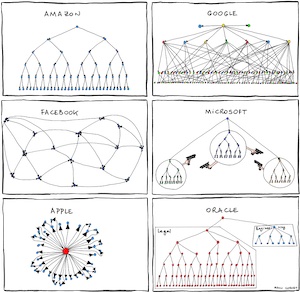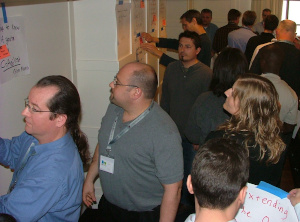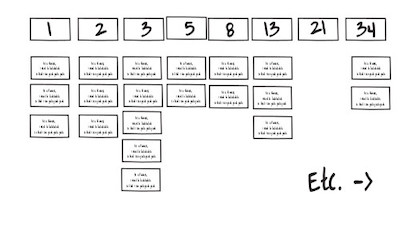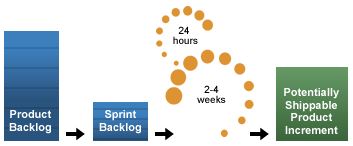 Scaling scrum is all the rage. People love to debate the merits of the various scaling frameworks: LeSS, SAFe, Nexus, Scrum@Scale, Disciplined Agile, FAST Agile, Spotify’s approach, and others. The underlying assumption is that the way to scale up value production is by increasing the number of people and teams. More people and teams can get more done, right? Perhaps, but there are significant costs to scaling up headcount, and alternative ways to scale up value production.
Scaling scrum is all the rage. People love to debate the merits of the various scaling frameworks: LeSS, SAFe, Nexus, Scrum@Scale, Disciplined Agile, FAST Agile, Spotify’s approach, and others. The underlying assumption is that the way to scale up value production is by increasing the number of people and teams. More people and teams can get more done, right? Perhaps, but there are significant costs to scaling up headcount, and alternative ways to scale up value production.
Read the full article…
Author Archives: Chris Sims
Agile Conferences For 2021
This page is old. Checkout the best list of agile conferences on the web.
 I recommend conferences and MeetUps as a great way to learn, network, and earn Scrum Educational Units (SEUs). This past year was challenging for such events. Many were cancelled. Some managed to inspect and adapt, moving online.
I recommend conferences and MeetUps as a great way to learn, network, and earn Scrum Educational Units (SEUs). This past year was challenging for such events. Many were cancelled. Some managed to inspect and adapt, moving online.
I’m pleased to share our 2021 list of agile, and agile adjacent, conferences. It’s the largest list we’ve ever published.
Velocity: Is More Really Better?
 A product owner recently asked if it was okay to want more velocity from their team. Their team usually completed product backlog items (stories) that totaled about 180 points every sprint. The product owner thought: if my team could increase velocity to 200 points every sprint, that would be better.
A product owner recently asked if it was okay to want more velocity from their team. Their team usually completed product backlog items (stories) that totaled about 180 points every sprint. The product owner thought: if my team could increase velocity to 200 points every sprint, that would be better.
I think it’s very much a part of the human condition to always want more. However, I’m not sure velocity is what you want more of.
Read the full article…
Sprint Review – Key To Higher ROI
 Scrum teams are expensive. Salaries and the other costs of maintaining a team represent a significant investment. A well run sprint review can dramatically improve the return your organization gets on this investment (ROI). Sadly, sprint review is widely misunderstood, and poorly implemented. The result is wasted time and lost opportunity. Let’s explore how to unlock the value of sprint review.
Scrum teams are expensive. Salaries and the other costs of maintaining a team represent a significant investment. A well run sprint review can dramatically improve the return your organization gets on this investment (ROI). Sadly, sprint review is widely misunderstood, and poorly implemented. The result is wasted time and lost opportunity. Let’s explore how to unlock the value of sprint review.
Read the full article…
Easy Estimation With Story Points
 Relative estimation, using story points, has proven itself superior to traditional time-guessing approaches. Common approaches to creating story point estimates, notably planning poker, aren’t great at getting the whole team involved in the conversation. Usually, only the outliers participate. This article describes a better approach, which we have been using with our clients for years.
Relative estimation, using story points, has proven itself superior to traditional time-guessing approaches. Common approaches to creating story point estimates, notably planning poker, aren’t great at getting the whole team involved in the conversation. Usually, only the outliers participate. This article describes a better approach, which we have been using with our clients for years.
Read the full article…
GROW Your Retrospectives
Question:
I have been assigned as the PO to a non-development scrum team for product marketing. After one week of work, we have delivered only 2 banner ads from a team of 10 people. The problem seems to be the process of approvals, reviews, kickoffs, briefs, tickets etc that need to happen in order to deliver the work. How would you coach me to help everyone see that our current process could be improved?
Answer:
 My first recommendation is to address this in the team’s retrospective. As product owner, it’s appropriate for you to say you would like to see the team get more ads, or other product backlog items, done in a sprint. Be a bit careful though; it’s very easy for the team to hear that as you blaming them or thinking that they’re not working hard. From the tone of your question, I don’t think that’s where you are coming from, but still be aware they may interpret things that way.
My first recommendation is to address this in the team’s retrospective. As product owner, it’s appropriate for you to say you would like to see the team get more ads, or other product backlog items, done in a sprint. Be a bit careful though; it’s very easy for the team to hear that as you blaming them or thinking that they’re not working hard. From the tone of your question, I don’t think that’s where you are coming from, but still be aware they may interpret things that way.
In the retrospective, you might consider using the GROW model that I’ve been writing about recently. GROW is designed for coaching, but it’s also great for structuring a retrospective. It stands for: Goal, Reality, Options (and Obstacles), and Way Forward. It’s an arc that you, or the scrum master, might guide the team through.
Read the full article…
Coaching Questions With GROW
 My previous article covered the GROW coaching model. This article builds on that by adding coaching questions. Questions are a powerful tool a coach uses to help the client find their own way forward. While the coach can provide information and guidance, a key element of coaching is supporting the client in solving their own problem.
My previous article covered the GROW coaching model. This article builds on that by adding coaching questions. Questions are a powerful tool a coach uses to help the client find their own way forward. While the coach can provide information and guidance, a key element of coaching is supporting the client in solving their own problem.
Some questions help the client see things in a new way, or consider things they hadn’t before. Much of coaching is deep listening. Questions are the invitations we give to our clients, asking them to share with us. They also allow the coach to gently guide the client’s examination of the situation, and ultimately move them into problem solving and action planning.
Read the full article…
GROW Coaching Model
Agile coaches often encounter clients that are stuck. They know what they are doing isn’t working, yet they can’t find their way out of the dysfunctional cycle. At least, not alone. The coach’s job is to help their client:
- gain deeper understanding of their situation
- create a vision for a better future
- identify obstacles & options
- create an action plan
 GROW is a framework that a coach uses to guide their client through this process. The client might be an individual, team, or even a whole organization. GROW is an acronym for the stages of the coaching process: goal, reality, obstacles (and options), and the way forward (will do). Let’s walk through the stages of the model, in the context of Scrum.
GROW is a framework that a coach uses to guide their client through this process. The client might be an individual, team, or even a whole organization. GROW is an acronym for the stages of the coaching process: goal, reality, obstacles (and options), and the way forward (will do). Let’s walk through the stages of the model, in the context of Scrum.
Online Office Hours With Chris, And More!
 The COVID-19 situation has brought many changes and challenges. Every change creates new possibilities for something good. For Agile Learning Labs, it gives us the opportunity to connect with our community in new ways.
The COVID-19 situation has brought many changes and challenges. Every change creates new possibilities for something good. For Agile Learning Labs, it gives us the opportunity to connect with our community in new ways.
Online Meetups
We are moving our MeetUp group online. The Scrum Professionals MeetUp group is going to resume our regular schedule starting this month. Tune in every third Wednesday of the month for a talk or workshop, as well as facilitated open discussion. We will continue having time for job seekers and companies to connect.
Online Office Hours
Every Monday afternoon, you are invited to join me for my open office hour: 3:00 PM – 4:00 PM PDT. This is your chance to ask me anything, and get free advice and coaching. I’m planning to use a Lean Coffee approach to structure each office hour, so the most important and popular topics get the most attention. Each office hour will be listed as a free event in the Scrum Professionals MeetUp group.
Read the full article…
An Abridged History Of Scrum
 I spend my working days helping companies use scrum and other agile practices to create healthier working environments and increased business value. Today, I found myself reflecting on the path that led here. Below is an abbreviated timeline of events in the evolution of scrum. I’ve included a few bits of my journey with scrum as well.
I spend my working days helping companies use scrum and other agile practices to create healthier working environments and increased business value. Today, I found myself reflecting on the path that led here. Below is an abbreviated timeline of events in the evolution of scrum. I’ve included a few bits of my journey with scrum as well.
An Abridged History Of Scrum
1970
Winston Royce publishes “Managing The Development Of Large Software Systems.” This paper is often cited as the origin of waterfall development. While Royce describes what became known as waterfall, he argues against it in the paper. He actually advocates for a more iterative, two pass approach, instead of the single pass of waterfall.
